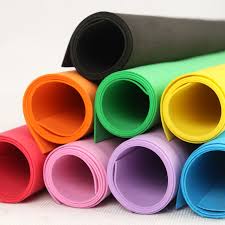16.08.2021
EVA foam is the acronym for the closed cell ethylene-vinyl acetate copolymer foam used as an effective substitute for a variety of materials used in production. It is a suitable substitute for natural rubber, vinyl, neoprene, polyurethane and PVC foams, wood composites, felts, fiberglass, and mineral wool. The EVA foam material characteristically provides good gloss and clarity, remains strong at low-temperatures, retains its resistance to UV radiation and stress-cracking, and possesses hot-melt adhesive waterproof properties.
Benefits gained from using the EVA foam substitute in production are comparable to traditionally used materials that exhibit
• vibration and impact absorptions,
• weather and chemical, oil, and fuel spill / splash resistances,
• thermal insulation and acoustical properties, and
• resilience / buoyancy and low-water absorption.
Common Uses
EVA foam has a fine uniform cell structure that allows it to be processed much like other thermoplastics. It retains its flexibility and resilience, quickly recovers from compressions, and absorbs colors. The foam is typically formed in a mould which becomes a sheet of closed cell foam (“a bun”). Bun dimensions vary depending on the density of the foam. The bun is cut into sheets or fabricated into a specific shape or item per specification.
EVA foam is extremely versatile with innumerable uses and applications that are generally taken for granted by most of us. EVA foam may be found in all types of appliances, automotive, building, marine, electronics, healthcare, packaging, sports, leisure, and recreation, and footwear. For example:
• EVA is competitively used in place of rubber and vinyl products in many electrical applications.
• EVA is used to give plastic wrap its “clinginess.”
• EVA emulsions are developed into adhesives used in packaging, bookbinding, bonding plastic films, metal surfaces, and coated papers.
• EVA is used with wax and resin additives to make hot-melt adhesives, hot glue sticks, and top notch soccer cleats.
• EVA craft foam sheets are used to make children’s foam stickers.
EVA is also used as a biomedical drug delivery application to slowly release a compound within the body. The polymer is dissolved in an organic solvent, blended into a homogeneous mixture, and molded into a freeze dried solid. Although it does not biodegrade within the body, it is inert and causes no adverse reaction.
EVA is expanded or foam rubber, which is used for sports equipment padding. Snow and water ski boots, bicycle saddles, hockey pads, boxing gloves and helmets, and fishing rods and reels are constructed with EVA foam.
EVA is used in sports shoes to absorb impact shock. It is a popular material for slippers and sandals because it forms to fit the foot, it is light weight, it does not hold odors, and it provides glossy finishes. Compared to natural rubber, EVA is a much more cost effective material.
Because EVA is a buoyant material, it is used in fishing and water sports gear as well as non-traditional items like floating eyewear. It is used as a substitute for cork for fishing rod handle butt-ends.
Other uses include, but are not limited to:
• encapsulation material for crystalline silicon solar cells (for photovoltaic modules),
• a cold-flow improver for diesel fuel,
• HEPA filter separaters,
• thermoplastic (sports) mouth guards (that soften in boiling water for a custom fit), and
• nicotine transdermal patches.

